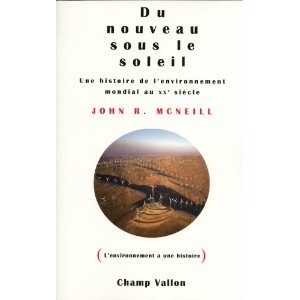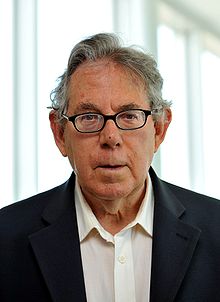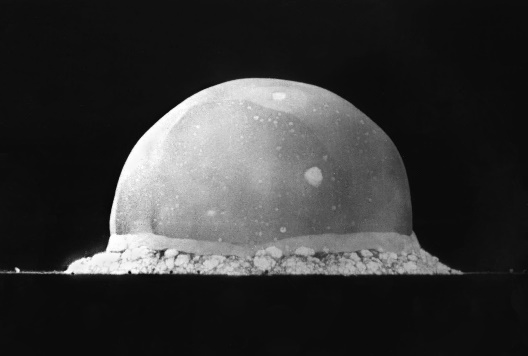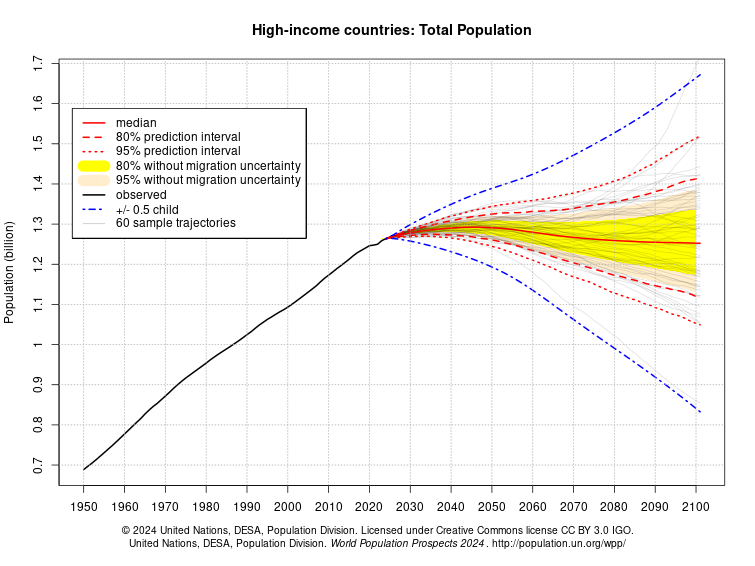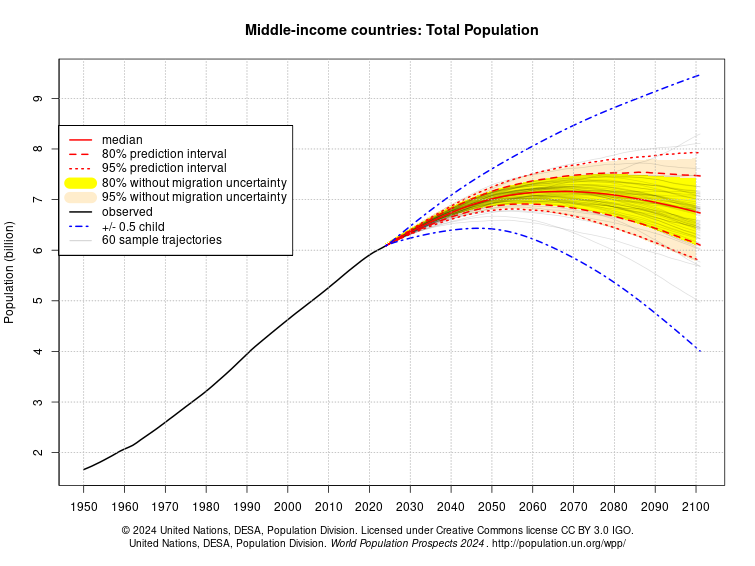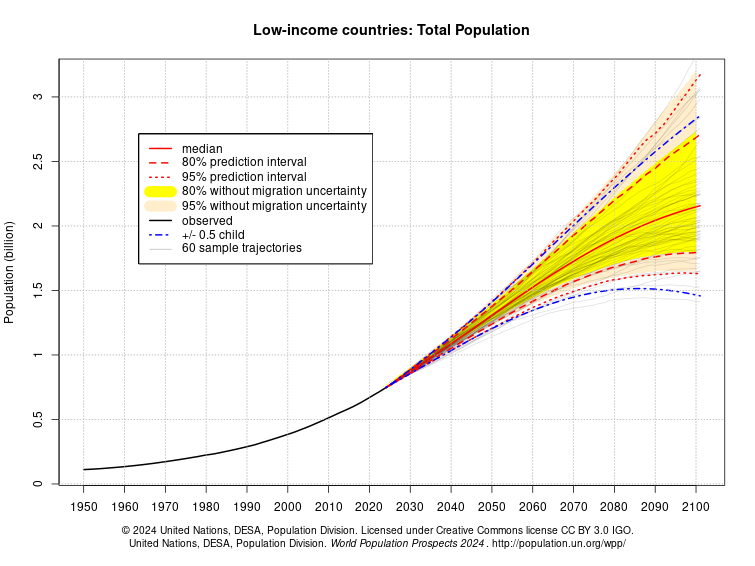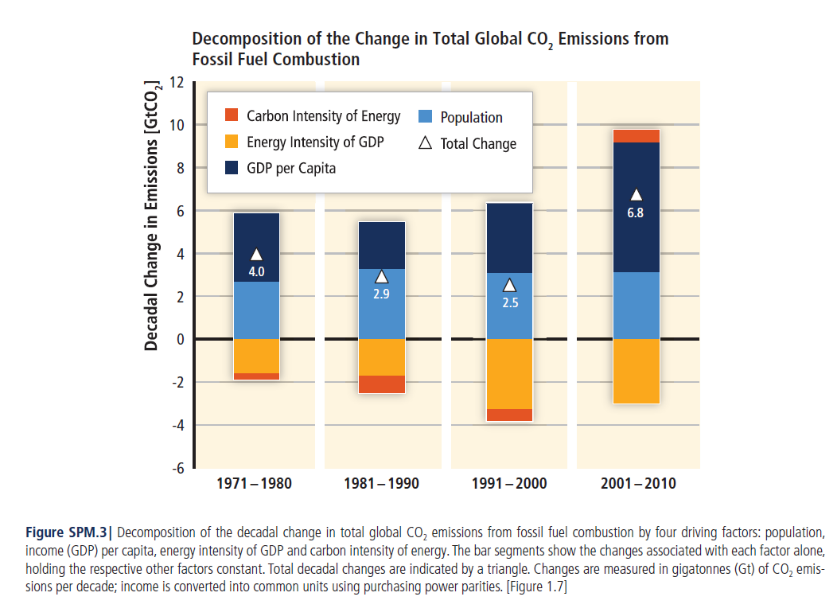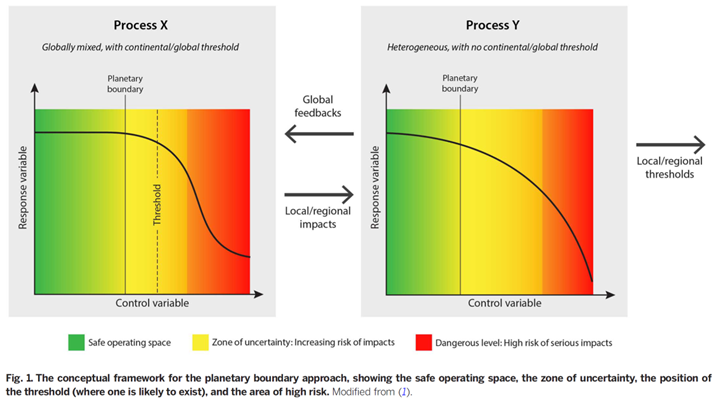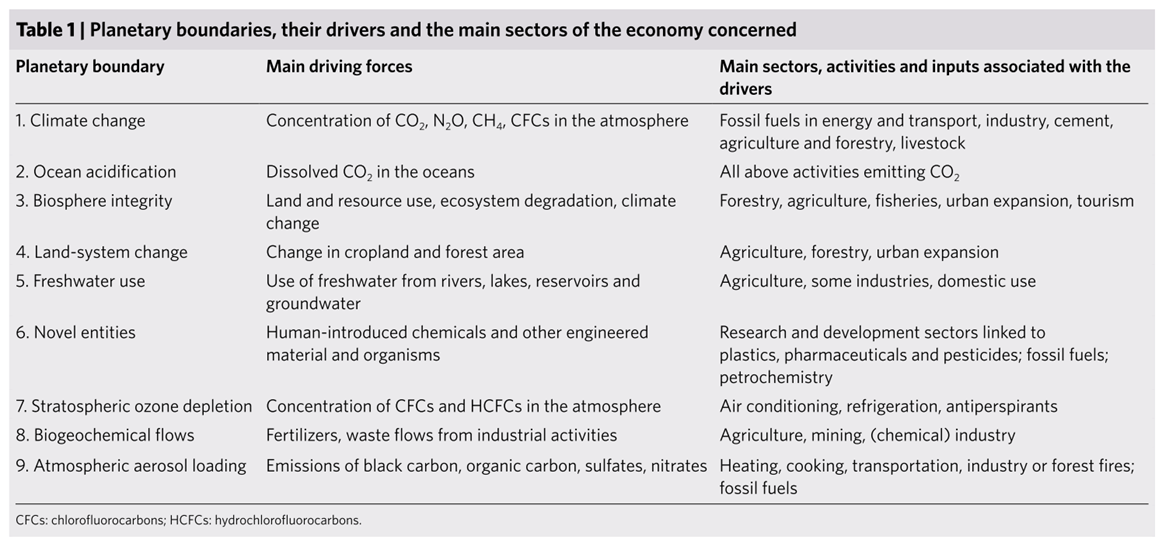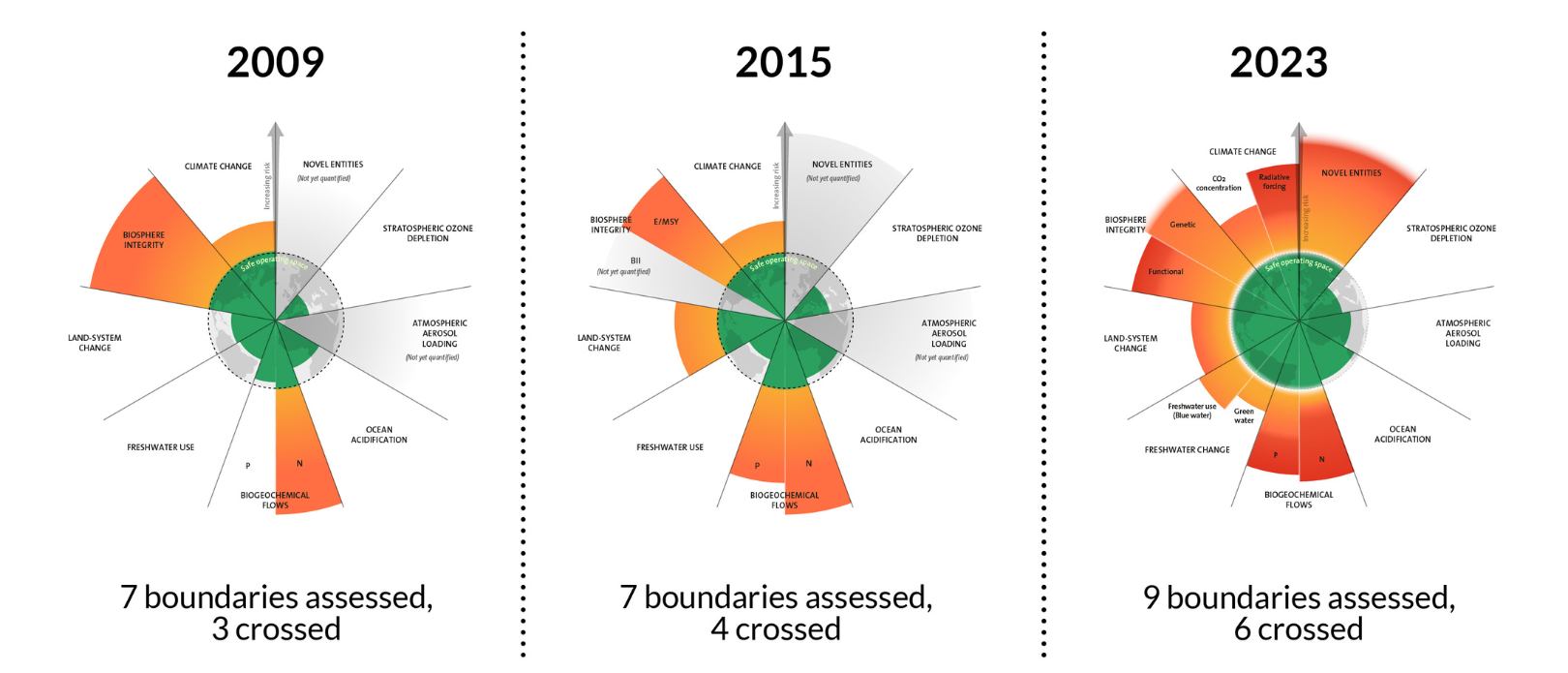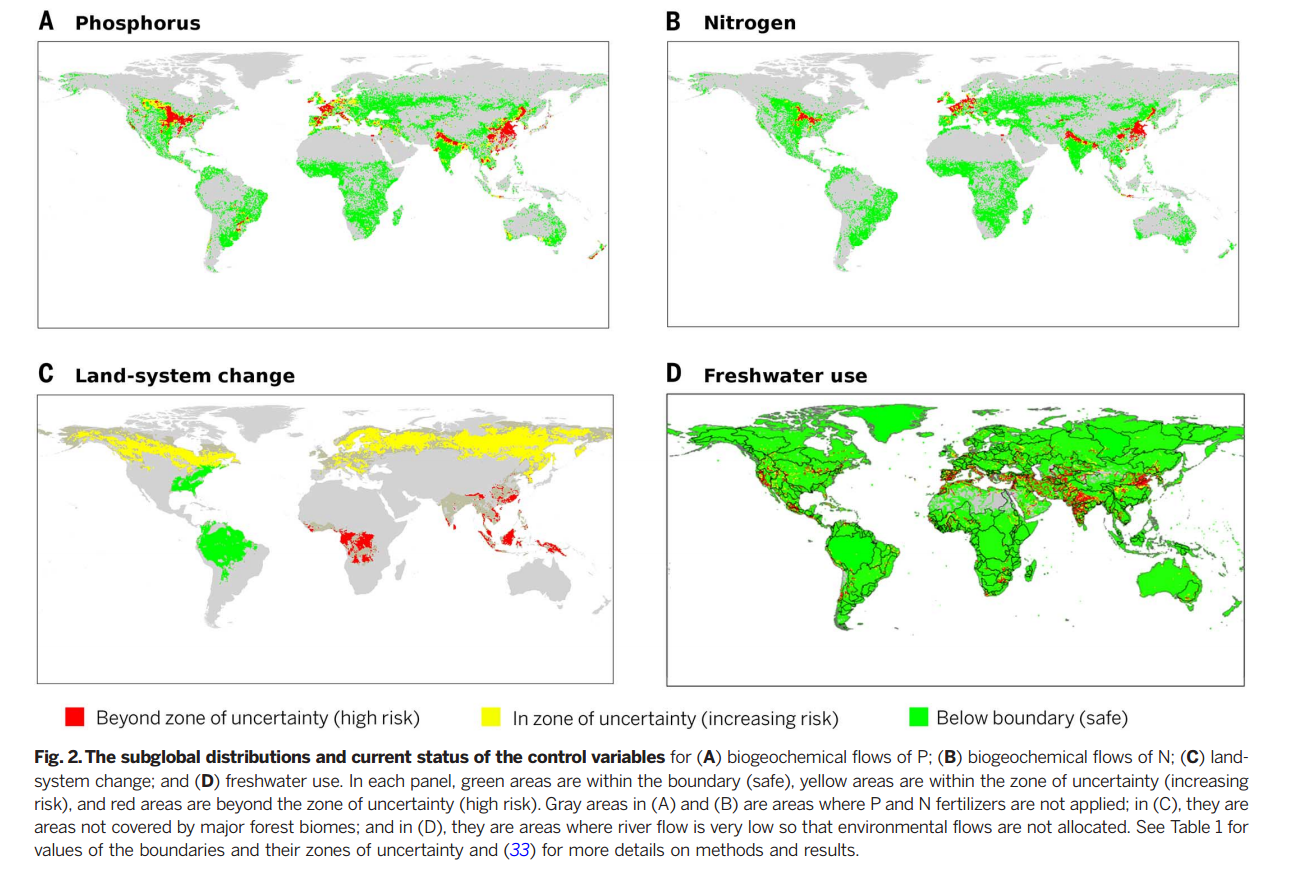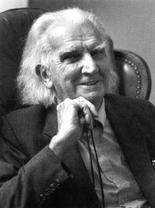Carrying Capacity of the Planet
More and more humans
More and more humans
The Great Acceleration in the Anthropocene
Population projections (UN 2017 and 2024)
GDP, production and consumption projections
From pressure to boundaires
A (temporary) conclusion
Human population history
| Population (in billions) | 1 | 2 | 3 | 4 | 5 | 6 | 7 | 8 | 9 |
|---|---|---|---|---|---|---|---|---|---|
| Year | 1804 | 1927 | 1960 | 1974 | 1987 | 1999 | 2012 | 2025 | 2040 |
| Years elapsed | 123 | 33 | 14 | 13 | 12 | 13 | 13 | 15 |
Klein et al (2010) estimation of world population
Cropland settlement across time Europe
Cropland settlement across time World
The Great Acceleration in the Anthropocene
More and more humans
The Great Acceleration in the Anthropocene
Population projections (UN 2017 and 2024)
GDP, production and consumption projections
From pressure to boundaires
A (temporary) conclusion
Anthropocene: The Great Acceleration
Initially published in 2004, following McNeil “Something New Under the Sun: An Environmental History of the Twentieth-Century World”, accounting for quantitative history of human-environment interaction. Updated in 2015, data up to 2010.
- Video version : Welcome to the Anthropocene
Anthropocene (Paul Crutzen, 2000’s, earlier occurrences in 1938, 1960’s) is a geological period identified as a layer specific to human activity.
Layer of radioactive material after nuclear tests and layer of pollution can be measured (stratigraphy).
Starting date of anthropocene has been proposed to be 1945, first nuclear explosion (Trinity, test before Hiroshima and Nagasaki).
We’ll talk later of W.F. Ruddiman’s early anthropocene hypothesis
The Great Acceleration: causes
- Population increases
- Expected to stabilize to 10b people by 2050
- Confidence interval large [8b,12b], revised lately downward
- Date of plateau unsure, could be 2100
- Main uncertainties
- Life expectancy, demographic transition, impact of cure&illness
- Impact of climate change and climate induced violence
- GDP per head accelerates
- Main driver, great convergence
- 1b people in developed countries
- 3b peoples in rapidly growing countries
- 3b in emerging countries
- 3b more to come in the next decades
- Main trends
- 1950 acceleration
- Globalisation inducing a new acceleration
- Changing composition
- Some variables have started to plateau
The Great Acceleration: consequences
- Consequences on the global ecosystem are massive
- Emissions of GHG [CO2, CH4] induce global warming, and climate change
- But also cause acidification of oceans
- Nitrogen and phosphorus open loops are adding stress
- A rapidly changing environment, in amplitude and speed rarely seen in the past is in “global mass extinction” scope
- Risks are to cross tipping point
- Irreversible change
- Loss of environmental services
- Fall in support capacity of environment
- Agriculture, infrastructure, ecosystems can collapse
- Human life support compromised
Population projections (UN 2017 and 2024)
More and more humans
The Great Acceleration in the Anthropocene
Population projections (UN 2017 and 2024)
GDP, production and consumption projections
From pressure to boundaires
A (temporary) conclusion
World 2017
World 2024
High Income Countries 2017
High Income Countries 2024
Middle Income Countries 2017
Middle Income Countries 2024
Low Income Countries 2017
High Income Countries 2024
GDP, production and consumption projections
More and more humans
The Great Acceleration in the Anthropocene
Population projections (UN 2017 and 2024)
GDP, production and consumption projections
From pressure to boundaires
A (temporary) conclusion
Arithmetic of growth
- Since 1950
- World population has tripled (2.5b -> 8.2b),
- Production per head has tripled (3.k$US23/cap/y -> 11.5k$US23/cap/y)
- Hence, production has been multiplied by more than 10 (12.5)
- In a close future (2100)
- Catching up is the rule
- There is nothing we can (nor should) do
- Convergence, right to development, diffusion of progress
- Best practice, capital, technology at disposal, high yield of investment
- Today 1.2b people live as we live (41k$US23) (EU+USA+Japan+other developped countries)
- 6.1b are poorer (5.9k$US23); China+India+other developping countries are growing fast
- low income (.7b) catching up also (0.7k$US23)
- Catching up is the rule
- Production may more than triple (3.8 to 7.6) in the next 70 years
- From 10.7k$US23/cap/y to more 41k$US20/cap/y (more or less, total dependancy ratio will mitigate a little bit that (65% -> 70%))
- With equal population, production is going to be multipled by 5 since now (~50 times 1950)
- World population should stabilize around 10b people, meaning 20% increase to come
- Another doubling of production with 1.%/y of total factor productivity growth over 70y
- Grand total: more than 10 times today production in 2100
From GDP to pressure: the case for energy


- Rich countries : 1.2b peoples ; income 41k$US23; 4.7 toe/cap/y constant
- Developing countries catching up: 6.1b people ; income 5.9k$US23; 0.975 toe/cap/y increasing
- Total energy consumption from 11.6 to 34.3 (Gtoe/y, \(\times\) 2.95), GDP per cap from 11.7 to 41 (\(\times\) 3.5) in the case of pure convergence elasticity is .85 (no or small decoupling)
- Including low income: energy $$3.25; gdp \(\times\) 3.8, elasticity is the same
- If technical progress is taken in account, then elasticity is divided by 2 (energy increase is the same; production doubles; decoupling)
- If digitization, IA or recycling, or direct capture increase energy needs, elasticity could be more than 0.5, even more than 1 (coupling)
Business as usual
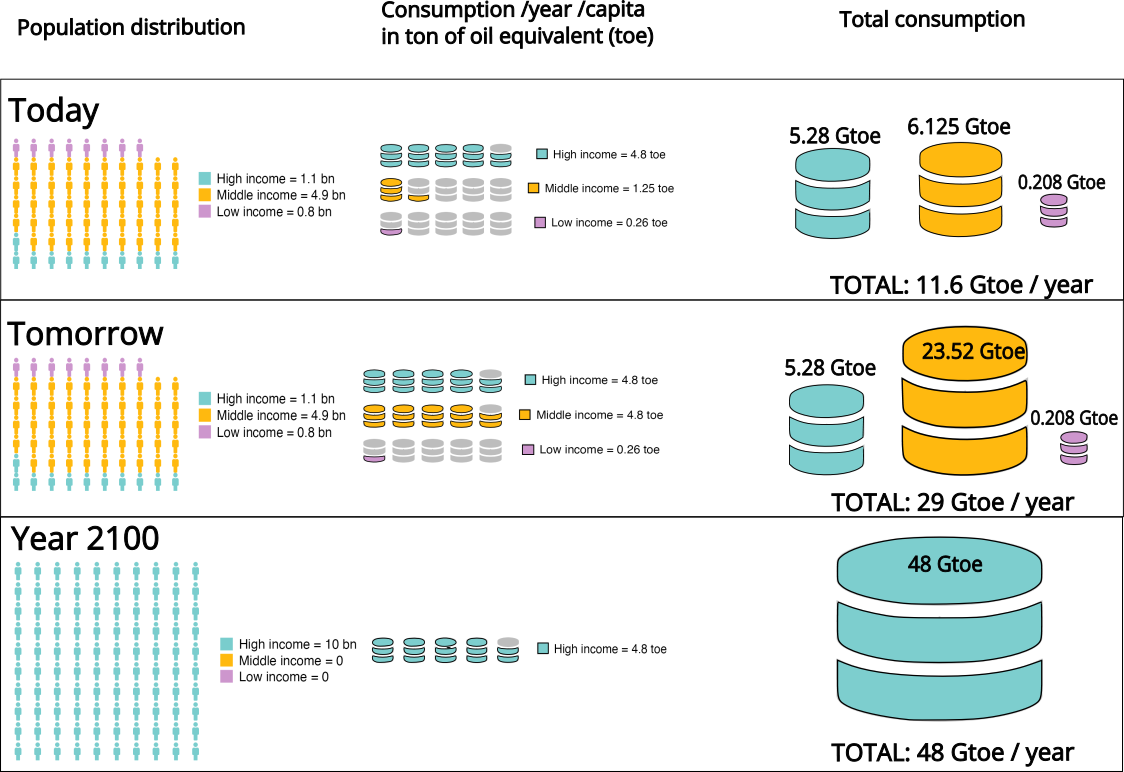
From pressure to boundaires
More and more humans
The Great Acceleration in the Anthropocene
Population projections (UN 2017 and 2024)
GDP, production and consumption projections
From pressure to boundaires
A (temporary) conclusion
Wrap up: pressure on earth going over the limit
- Natural resources exhaustion
- Depletion of oil, coal, gaz, other fossil energy
- Soil depletion: agriculture; deforesting; erosion
- Renewable ressources consumed beyond sustainable threshold
- Pollution
- Saturation of the capacity of the ecosystem (biosphere) to absorb waste produced by human consumption
- Some NGO evalue 1 year of waste to 4 years of process by ecosystem
- Hydric capacity saturation
- Direct destruction of environment, loss of biodiversity, through destruction of livable zones or direct pollution
- Climate change
- Mainly through CO2 emissions
- smoke; dust; methane; airplanes in high atmosphere (water condensation); other GH gazes play a role as well
More and more people, richer and richer
- We depend on environmental services
- Water services
- fresh, regular flow, drinkable
- Soils conservation & protection
- vegetation prevents erosion
- mangroove prevents coastal erosion
- Alluvion transports regenerate soils
- Water capture prevent salts to go up (anti salinization)
- Food production
- wild life, plants, bees
- Waste processing
- Closing cycles for nutrinents and essential components
- We use a lot of energy - nearly unlimited solar supply, but it is costly to capture - Limited but nearly free supply of fossil fuel
Climate pressure: World CO2 and equivalent emissions
Kaya identity
\[CO_2= Pop \times \frac{GDP}{Pop} \times \frac{E}{GDP} \times \frac{CO_2}{E}\]
- Accounting or decomposition identity, no model, no structure in it
- Can be used in various situations with as many terms needed
Boundaries are defined as:
- Indicators, critical to life, with an anthropogenic forcing
- Subject to tipping points (supposed or expected)
- Threshold unknown or not well known
- Crossing the threshold would be irreversible (or for a long time)
- Consequences of being beyond threshold unknown (untested)
- Not only a threshold but also a speed to the threshold (and beyond): reducing adaptation possibility of humans, human societies, ecosystem humans depends on
Boundaries over time
Local (regional) carrying capacity
A (temporary) conclusion
More and more humans
The Great Acceleration in the Anthropocene
Population projections (UN 2017 and 2024)
GDP, production and consumption projections
From pressure to boundaires
A (temporary) conclusion
Madman or economist ?
Anyone who thinks that you can have infinite growth on a planet with finite resources is either a madman or an economist
The great acceleration: Impact of human activity has increased rapidly since WWII
Climate change is one limit (among other) to human activity on earth
- Carrying capacity or Carbon budget
Global degrowth (think less energy) is hard to implement
- however look at Engler et al., « 15 years of degrowth research ».)
- Decarbonizing is decoupling (absolutly) emissions (from GDP)
Whereas it does not impose zero growth or negative growth, it has strong consequences on economic possibilities
- it imposes a change in relative prices (changing definition of output, modifying relative scarcities)
- it will have strong distributional consequences
- it will be a major organizational challenge

Carrying Capacity of the Planet EoE 2025: The Age of Constraints




